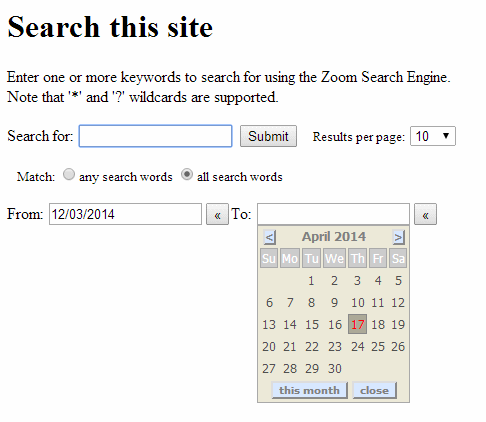Zoom - Date range searchingThis page aims to help you with setting up your website to utilize Zoom's date range and sort by date feature on the the search page. You can configure Zoom to display the date and time for each search result and allow the user to sort their results chronologically.Note that to do this, you may be required to edit your current files on your server or create additional .desc files if you aren't able to do so. First, you will have to enable and configure Date Range searching and Sort Results by Date in the Indexer's Search Page configuration window under Search improvements options. With Date Range Searching enabled, the visitor will be able to specify a date range which search results must fall between. Specifying a last-modified date for your web pagesBy default, webpages normally uses the last-modified date and time of the file according to the webserver. However, sometimes your webpages does not report a time, an incorrect time or the time it does report is not very useful (such as those of dynamically generated web pages where it would use the date and time of the server-side script as opposed to a date that is related to the content actually displayed). In these cases, you can specify your own last-modified date and time in the form of a "http-equiv" Meta tag. Or if you cannot edit the document, you can provide your own last-modified date and time in a .desc file associated with the page/document to be indexed. Option A: Using http-equiv meta tag To specify the date and time using http-equiv meta tag, do so such as the following: <meta http-equiv="Last-Modified" content="Sat, 07 Apr 2001 00:58:08 GMT">
Note that this is a standard Meta tag and would also be used by other spiders and applications. The meta tag should be in the <head> section of your HTML page. Option B: Using a .desc file As some external binary documents may not contain useful, descriptive, or correct information, Zoom allows you to specify custom Meta information for any plugin supported files. The option can be enabled in the indexer configuration dialog and must be enabled for each plugin. Once it is enabled, the indexer will look for .desc files for this plugin supported file extension. For example, if you have a file called "mydocument.doc", you can create a text file called "mydocument.doc.desc" in the same directory with the following contents: <meta http-equiv="Last-Modified" content="Sat, 07 Apr 2001 00:58:08 GMT">
Zoom will then index the words found within "mydocument.doc", but use the last modified date found in "mydocument.doc.desc" - so that you can view and sort the date within your search results. You can also specify other meta information in .desc files, including extra keywords, title, descriptions, etc. See the Help File or Users guide for more examples. Regardless of the method you choose, the exact syntax for specifying the date and time must be followed. The expected format for the date value is: ddd, DD MMM YYYY HH:MM:SS [Timezone]
Date Range Searching - Date pickerWhen this option is enabled, the visitor will be able to specify a date range which search results must fall between. The user must specify a From date and a To date with the date picker control (or they can type in the date).
During your next index after this Date Range search feature is enabled, you will find two additional files created in your output directory ("zoom_datepicker.js" and "zoom_datepicker.css"). These files will need to be in the same folder as the other Required Files for your index. While the date picker should work without any further changes, it is best to add the CSS styles to your template for aesthetics reasons (so that the clickable parts of the date picker control will look like buttons). You can do this by either copying the contents of "zoom_datepicker.css" into the <style> section of your template HTML page, or you can simply link to the file like so: <link rel="stylesheet" href="zoom_datepicker.css" type="text/css">
Of course, you can modify the CSS with different colors or font types or sizes to suit your web site. See the following help page for further info. To perform a search without any date range, simply blank out the From and To text fields. Return to the Zoom Search Engine Support page |
